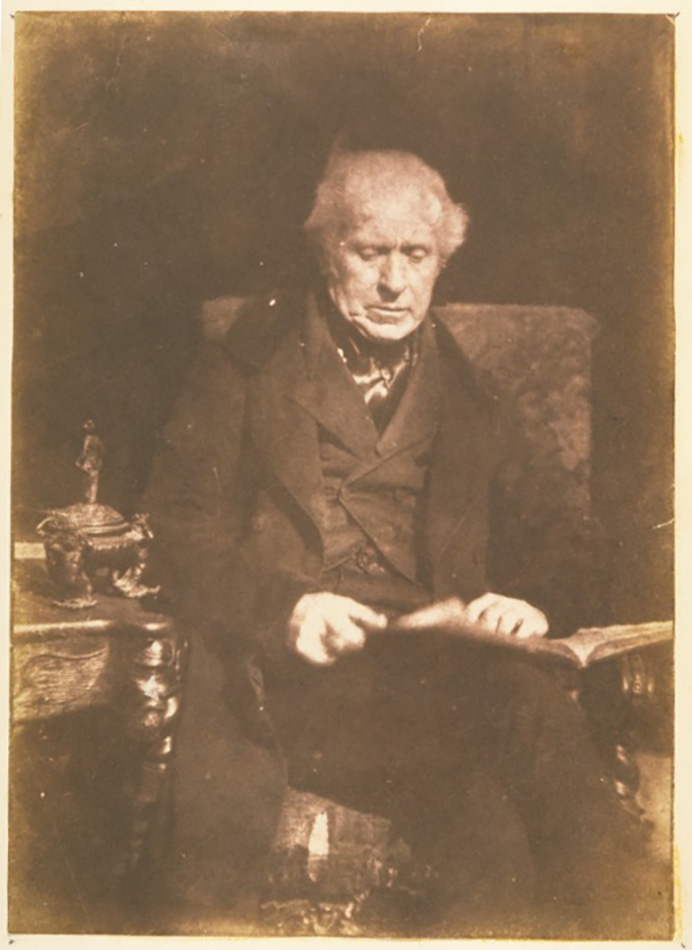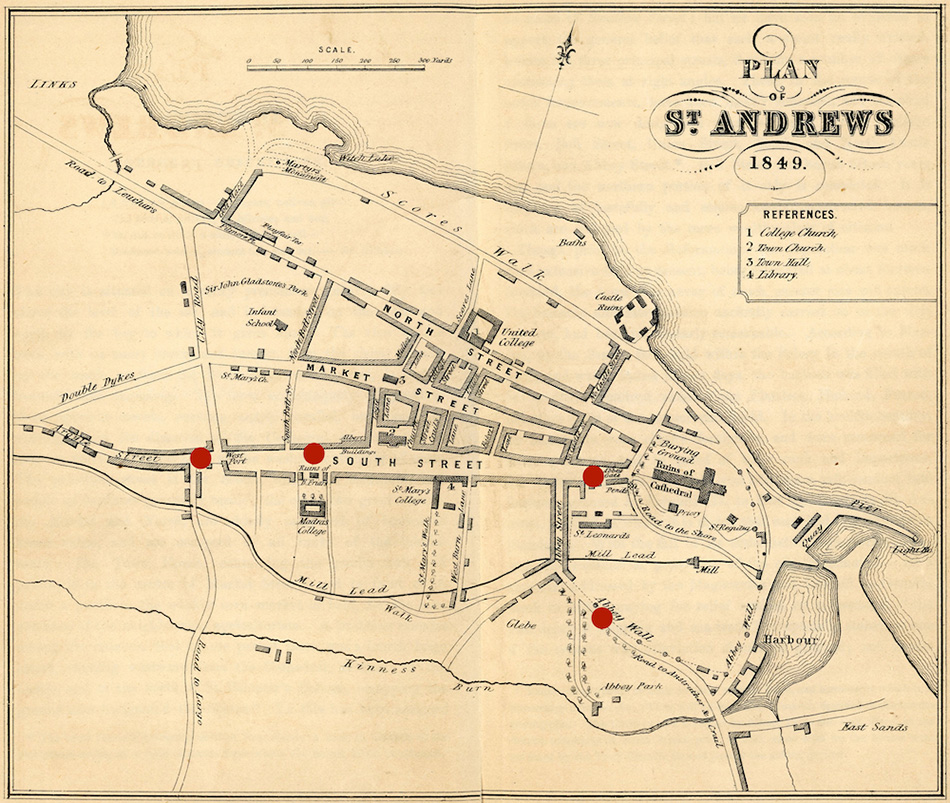St Andrews then and now: A rephotography project: Part I
PhD candidate Édouard de Saint-Ours introduces a mini-series of posts which coincides with the St Andrews Photography Festival.
For a historian of photography, living in St Andrews can often feel like being a kid in a candy store. Although small and still very isolated in the 1840s, the town played a central role in the early developments of photography in Britain. The driving force behind this evolution was Sir David Brewster (1781-1868), an admired scientist and Principal of the United College from 1838 to 1859.

Brewster was in regular correspondence with William Henry Fox Talbot (1800-1877) and convinced the inventor of photography on paper not to patent his calotype process in Scotland. He also publicly showcased calotypes in St Andrews in 1840 and shared the process with fellow members of the local Literary and Philosophical Society as early as 1841. Brewster later introduced the painter David Octavius Hill to the photographer Robert Adamson, initiating a celebrated artistic partnership that lasted from 1843 to 1847.
As a consequence, St Andrews became the first town in the world to be thoroughly documented by the camera. The views captured by pioneering photographers more than 170 years ago are still familiar to both town and gown. Although some have been destroyed or altered by the addition of more recent structures, most of them remain almost unchanged.
When walking through the streets of St Andrews, I am constantly reminded of these now-familiar early photographs. Some views even make me feel as if I had stepped back to Victorian times. Eager to share this peculiar sensation, I decided to select a number of photographs from Special Collections, and to identify and rephotograph the exact views.
All the original prints selected for this series were made before 1860 and are now pasted onto album pages. Using my very own Samsung Galaxy A3 (practical though unromantic), I created modern copies of these pictures so they could be compared closely through the online software JuxtaposeJS, which enables an examination of the differences and similarities between two pictures by simply dragging an interactive line across an embedded illustration (click on the images below to see the interactive illustrations).
The series will be broken up into five blog posts, published every Wednesday over the coming weeks. Each will focus on a specific area of St Andrews, and highlight relevant information relating to the history of photography and the history of the town.
As 2019 marks the 180th anniversary of the invention of photography, this project will act as a bridge across almost two centuries of photographic history. It will bring two very different techniques into comparison, and – I hope – highlight the magical capacity of photography to materialize the past; letting us hear, like a stream in the distance, the faint but inexorable flow of time.
South Street

Let us now start our photographic stroll by entering historical St Andrews through the picturesque West Port. Built in 1589 where an earlier gateway used to stand (and modelled on the Netherbow of Edinburgh), the port was not intended for defence but rather as a mark of civic pride and prestige. It was renovated in 1843 by John Grant, who added a plaque with the city’s coat of arms on the east side, and a sculpted depiction of David I (who bestowed municipal privileges to the town) on the west.
Thomas Rodger, The West Port, salted paper print, 1858. ID: ALB-6-39.
This photograph was taken fifteen years after the 1843 renovation by the local photographer Thomas Rodger (1832-1883). There are several other early views of the gate in the university collection, but this was the only one that could be recreated, the other pictures having been taken from right where a perilous roundabout now sits.
Born in St Andrews in 1832, Thomas Rodger was taught photography by Dr John Adamson (1809-1870), whom he assisted in his chemistry class at the university from 1849 to 1852. Encouraged by his mentor, Rodger established a photography studio near the east end of South Street in 1849, becoming St Andrews’ first professional photographer. He soon became very successful, regularly winning awards for his work. In the mid-1850s, Rodger learned the newly-developed collodion photography process and relocated to North Street.
Long exposures were needed to obtain successful calotype negatives. Unable to capture movement, the process therefore compelled sitters to pose for several minutes. This explains the rather stiff postures adopted by Rodger’s sitters, with some sedentary and others leaning against the port. They nonetheless bear witness to the photographer’s intention to animate the scene.
Thomas Rodger, Blackfriars Chapel from the north, salted paper print, 1850. ID: ALB-3-16-1.
Blackfriars chapel was already in ruins when it was photographed by Thomas Rodger in 1850. Formerly a side apse of a larger church which ran parallel with the street, it is the only remaining trace of a Dominican friary founded in 1464. A bequest from William Elphinstone, Bishop of Aberdeen in 1514 allowed building to begin and by 1525 the friary church was completed. But, in June 1559, following a series of sermons by the Protestant preacher John Knox, the friars were evicted and the friary was destroyed by townsfolk set on erasing all trace of ‘idolatry’ from St Andrews.
The structure hasn’t changed much since the mid-nineteenth century. Once again, Rodger made sure to include figures in the frame to animate the scene. Also apparent is the new pavement installed on South Street around 1842 and commissioned by the town’s Provost, Major Hugh Lyon Playfair (1787-1861), another local photography enthusiast.
David O. Hill & Robert Adamson, Abbey Wall, Abbey Walk, salted paper print, 1846. ID: ALB-23-16.
John Hepburn, prior of St Andrews, commissioned the construction of the current Abbey Wall in 1516 to enlarge the former ecclesiastical precinct. Nearly a mile in length, the wall still incorporates thirteen turrets at regular distances, adorned with gothic niches originally intended to host sculpted images.
This photograph by Hill & Adamson shows the north end of the Abbey Walk, and features one of these turrets. In the late 1830s, considered an unprofitable possession of the Crown, the wall was put up for auction, causing quite a stir in St Andrews. Fearing it might be bought and destroyed by a private contractor, townsfolk petitioned against the sale. According to Charles Roger, it was eventually acquired by the United College for £2600.
Hill & Adamson’s picture shows that public lighting was already provided in St Andrews at the time. According to Charles Roger, oil lights were set up in 1821, gaslights in 1835, and the original round lamps were replaced by square ones in the early 1840s, under Major Playfair’s tenure as Provost (1842-61).
David Octavius Hill (1802-1870) and Robert Adamson (1821-1848) met through Sir David Brewster in 1843. A painter based in Edinburgh, Hill was then working on a very ambitious composition immortalizing the Disruption of 1843, when 474 ministers broke away from the Church of Scotland to form the Free Church of Scotland. Brewster suggested that Adamson, an engineer and young photography enthusiast, could make photographic portraits of all those present during the Disruption Assembly to assist Hill in his endeavour.
Working on this and other projects, Hill & Adamson set up a successful portrait studio on Calton Hill that attracted intellectuals, artists, and the well-to-do from Edinburgh and beyond. They were assisted by Jessie Mann (1805-1867), who is arguably the first Scottish woman photographer. The compelling beauty of their pictures – most notably in the portraits they made of the fishwives and fishermen of Newhaven – has garnered them admiration that persists to this day.
Thomas Rodger, ‘Roundel’, South Street, salted paper print, 1850. ID: ALB-3-10-2.
David O. Hill & Robert Adamson, South Street and Cathedral, salted paper print, 1846. ID: ALB-23-11.
Taken near the east end of South Street, these similar photographs by Thomas Rodger and Hill & Adamson both feature the Pends and the Cathedral. These will be the focus of our next two blog posts. To their left is a conspicuous rotund tower known as the Roundel, probably built in the sixteenth century and remodelled in the seventeenth.
My rephotographed views of both compositions are somewhat inaccurate, because a fully-grown tree now occupies the exact spot where the photographers set their cameras at the time. Both pictures also show that there used to be a gate at the end of South Street, which led to the now demolished Priory House.
Next week, we will continue our photographic tour through time and space by entering the ecclesiastical precinct and examining early photographs of the cathedral.
Édouard de Saint-Ours
PhD candidate, University of St Andrews,
Université Le Havre-Normandie
Acknowledgements
I would like to thank Rachel Nordstrom for her continued support throughout this project and her precious advice. My gratitude also goes to Alex Cohen, who generously gave some of his own time to proofread these posts.
Bibliography
Brown, Michael and Katie Stevenson, eds. Medieval St Andrews: Church, Cult, City. Woodridge: Boydell & Brewer, 2017.
Crawford, Robert. The Beginning and the End of the World: St Andrews, Scandal, and the Birth of Photography. Edinburgh: Birlinn, 2011.
Di Folco, John. ‘St Andrews Preservation Trust Photographic Collection’. History of Photography 25, no. 2 (2001): 155-60.
Grierson, James. Delineations of St Andrews. Edinburgh: Peter Hill; St Andrews: P. Bowler; London: Vernor, Hood, and Sharpe, 1807.
Johnstone, Karen A. ‘Thomas Rodger, 1832-1883: A Biography and Catalogue of Selected Works’. MPhil dissertation, University of St Andrews, 1997.
Lyon, Charles Jobson. The History of St Andrews, Ancient and Modern. Edinburgh: The Edinburgh Printing and Publishing Co.; St Andrews: M. Wilson; Cupar: G. S. Tullis, and Gardiner and Anderson; Kirkcaldy: J. Cumming, and J. Birrell; Dundee: F. Shaw, and J. Chalmers; Perth: J. Dewar; Arbroath: P. Wilson; Montrose: J. and D. Nichol, and Smith and Co.; Aberdeen: Brown and Co.; London: Smith, Elder, and Co., 1838.
Lyon, Charles Jobson. History of St Andrews, Episcopal, Monastic, Academic, and Civil. Edinburgh: William Tait; London: Simpkin, Marshall, & Co.; Dublin: John Cumming, 1843.
Morrison-Low, A. D. ‘Dr John Adamson and Thomas Rodger: Amateur and Professional Photography in Nineteenth-Century St Andrews’. In Photography 1900: the Edinburgh Symposium, edited by Julie Lawson, Ray McKenzie and A. D. Morrison-Low, 19-37. Edinburgh: National Museums of Scotland, 1994.
Morrison-Low, A. D. ‘Brewster, Talbot and the Adamsons: The Arrival of Photography in St Andrews’. History of Photography 25, no. 2 (2001): 130-41.
Roger, Charles. History of St. Andrews. Edinburgh: Adam & Charles Black, 1849.
Stevenson, Sara and A. D. Morrison-Low. Scottish Photography: The First Thirty Years. Edinburgh: NMS Enterprises Limited-Publishing, 2015.
Great info except for mentioning 1839 as the beginning of photography. 1837 is well documented as the first year. For one source see https://www.dickermanprints.com/blog/a-brief-timeline-of-the-history-of-photography
Thank you for your comment Michael, I am glad you enjoyed the post. You are right, photography did exist before 1839. What is generally believed to be the oldest surviving photograph was made by Nicéphore Niépce in 1826-27. But some earlier experiments could also mark the beginnings of photography, such as Thomas Wedgwood's in the 1790s. In fact, it is difficult to pin down the precise moment when photography was born, either as an idea or an object. 1839 is the year when photography was publically showcased for the first time, which is why it is often used as a starting point, the only definite one we have...